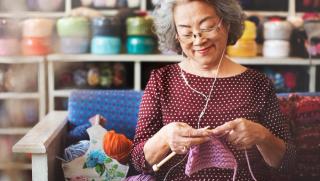Handicrafts and hobbies
Tactile crafts and sensory-rich activities, accessible for people with low vision.

Summary
There are many tactile crafts and sensory-rich hobbies and activities that can be just as fulfilling and maybe even more rewarding than visual activities. Here’s a guide to our top picks!
Cooking and baking
Cooking and baking are excellent hobbies for individuals with low vision. Adaptive kitchen tools, such as large-print or tactile measuring cups, talking timers, and safety gloves, make meal preparation safer and more accessible. Techniques like using contrasting-coloured cutting boards and maintaining an organised, clutter-free workspace enhance safety and efficiency. Smart ovens and one-pot meal options can simplify cooking while tools like liquid level indicators help to prevent spills.
Music
Music is a highly inclusive hobby that can be enjoyed with any level of vision. Playing an instrument can be made more accessible with tactile elements, such as raised frets on guitars, or tactile markers on piano keys. Braille music sheets or audio instructions can also make learning and playing music more accessible with low vision. Of course, you don’t have to learn an instrument to benefit from the therapeutic and social enjoyment of music! Explore genres and playlists that you enjoy or attend live performances and foster connections with like-minded people.
Games and puzzles
Games and puzzles are a fun source of entertainment and mental stimulation. Options like high-contrast checkers, tactile playing cards, or braille board games allow individuals or friends to enjoy classic games inclusively. Jigsaw puzzles with larger, high-contrast pieces or adaptive electronic puzzles are also available. Many classic and affordable family games are now available in jumbo sizes for better visibility. You could even try a family game of giant outdoor chess this summer!
Birdwatching
Birdwatching is an excellent activity to enjoy with low vision, especially in Australia, where the diverse bird population offers a unique auditory experience. Identifying birds by sound is particularly rewarding and impressive! To enhance your experience, focus on positioning yourself in quieter environments to better hear bird sounds, and start by learning the calls of common species in your area. Immerse yourself in the auditory beauty of nature. Tools like the ChirpOMatic app allow you to record bird sounds and identify species quickly, making it easier to engage with nature without relying on a visual.
Clay sculpting
Clay sculpting or pottery is hands-on and allows for creativity in shaping objects by feel, rather than sight. Pottery wheels or hand-crafting techniques like slab or coil can be used. If you’re interested in trying clay sculpting or pottery, search online for pottery classes near you, or try an at-home kit. You can find affordable air-dry clay kits at many discount and department stores.
Knitting or crocheting with chunky yarns
Knitting and crochet are excellent for people with low vision as they rely on touch and repetition, allowing projects to be guided by feel. Working with chunky and larger needles or hooks makes it easier to feel stitches, and tactile guides or high-contrast tools can help with navigation through patterns. Try crochet hooks size six and above, and use a tactile stitch marker, rubber band or paper clip to keep track of rows. For contrast, try a black crochet needle against white yarn, or similar. Start with a basic double crochet stitch to make a scarf or blanket. Repetitive patterns allow for “muscle memory” to develop, where the hands can start to recognise if a stitch feels off, enabling a flow that’s more intuitive and gets easier with time. Plus, the benefit of chunky yarn is that your project will emerge quite quickly!
Latch hook
Latch hook kits are great for people with low vision because they use large, easy-to-handle tools and pre-cut yarn, making the process highly tactile and accessible. The instructions are simple. Pull yarn through a canvas to create a tactile design that is satisfying to feel as it takes shape. The repetitive motion of latch hooking can be relaxing and is a nice way to stay connected to your artistic side. Seeing AI apps can be useful in helping you to identify colours if this is a challenge. Affordable latch hook kits can be found at discount and department stores, as well as online.
Woodwork
Woodworking is a rewarding hands-on craft. If you’re a beginner try a pre-cut woodworking kit that can be assembled largely by touch. Use sandpaper to remove rough edges and then start assembly with wood glue where possible. A nice starter project is a planter box for small plants or herbs.
A thought to leave with
Engaging in hobbies is a personal journey. With the right adaptions, people with low vision can stay connected to the activities you enjoy and continue exploring new interests along the way.
Did you find this article helpful?
Share your thoughts and help us make our resources better for everyone.
Enjoying the content?
Start building your profile to access personalised support, resources, and tools tailored to your eye health journey.
